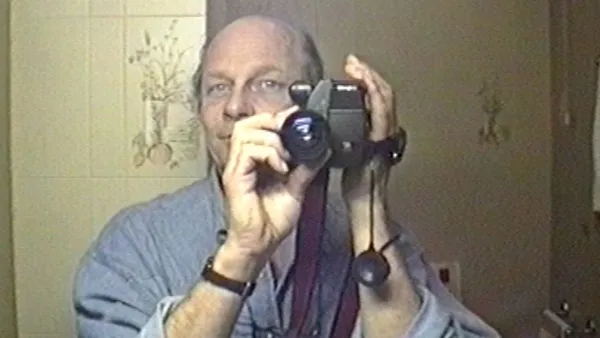 |
| Robby Müller: Living The Light director Claire Pijman will do a Q&A with Andrea Müller-Schirmer following the 2:30pm screening at Metrograph on Sunday, October 1 Photo: Claire Pijman |
Claire Pijman’s resourceful and enlightening documentary, Robby Müller: Living The Light (with a score by Jim Jarmusch and Carter Logan’s Sqùrl), is a big part of the series, Robby Müller: Remain in Light, at Metrograph that celebrates the legendary cinematographer, who died in 2018. Films by Wim Wenders (Alice In The Cities; The American Friend; Kings Of The Road; Paris, Texas; Wrong Move), Jim Jarmusch (Dead Man, Down By Law, Ghost Dog: Way Of The Samurai, Mystery Train), Sara Driver’s When Pigs Fly (post-screening discussion with Sara, Jay Rabinowitz, Andrea Müller-Schirmer, moderated by Hillary Weston on Friday, October 6, 8:30pm), Andrzej Wajda’s Korczak, Alex Cox’s Repo Man, Peter Bogdanovich’s Saint Jack, William Friedkin’s To Live And Die In LA, and Michael Winterbottom’s 24 Hour Party People will all be shown.
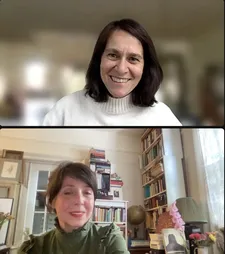 |
| Claire Pijman with Anne-Katrin Titze on Robby Müller and Wim Wenders’ Buena Vista Social Club: “That’s how I got to know him, and since then we stayed in touch and he was kind of my mentor.” |
Claire co-curated the Master Of Light Robby Müller exhibition at Amsterdam’s Eye Filmmuseum with Jaap Guldemond (director of exhibitions) and Andrea Müller-Schirmer (Robby’s wife) in 2016. A Ronnie Rocket message left by David Lynch, a good suggestion by Pjotr van Dijk, what two lines in The Goalie's Anxiety At The Penalty Kick script by Wim Wenders and Peter Handke would end up meaning, Michael Powell’s Peeping Tom and more were touched upon.
It started out with Claire getting a phone call from Robby Müller, asking her to work as a camera operator on Wim Wenders’ Buena Vista Social Club, which lead to meeting guitarist Ry Cooder and guitar maker Flip Scipio (featured in Claire’s 2017 documentary Talking Guitars with Carly Simon, Jackson Browne, Paul Simon).
From Amsterdam, Claire Pijman joined me on Zoom for an in-depth conversation on Robby Müller: Living the Light
Anne-Katrin Titze: Hi Claire! You used very original opening credits, on a table. I have never seen anything like that! How did that idea come up?
Claire Pijman: Actually, to be honest, it was an idea of my husband’s. We were working with normal titles, white on black. But the whole feeling for the film was to start looking and to start looking at light and how shadows work. Then we came across windows of shops with signs on them. And the sun was shining on it and it threw the letters on the floor or on the wall. And it was his idea to say: Shouldn’t you do it with light and shadow? There we were, busy all day getting it done.
AKT: Totally original.
CP: I’m glad you like it. Because from the beginning you should have the feeling that the film is about lighting, watching, and shadow.
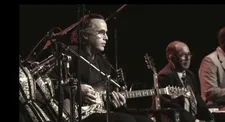 |
| Claire Pijman on meeting Flip Scipio at the Buena Vista Social Club shoot: “He was with Ry Cooder.” |
AKT: Very fitting with Robby Müller! Where did it all begin? How did you meet him?
CP: I know Robby through his wife Andrea. I was working on a set [Paula van der Oest’s Always Yours, For Never] and she was doing costumes there. I was a camera assistant and focus puller at the time.
AKT: Which set was that?
CP: It was a short film and I knew the DoP. I actually already stopped being an assistant, but I knew this DoP well and she said “Can you do it one more time?” And I said okay. Andrea knew me as a focus puller from that set and I didn’t know she was Robby Müller’s wife. So suddenly I get a call from Robby Müller himself, saying “Hey, my regular assistant is not available, could you be my assistant?” Of course I was surprised being called by Robby Müller, but I said to him that I had promised myself that this was my last film as an assistant. I really want to be DoP.
Instead he said, okay, and invited me to their house. The next thing he asked was doing one of the cameras on Buena Vista Social Club for Wim Wenders. That’s how I got to know him, and since then we stayed in touch and he was kind of my mentor. I work also a lot in documentaries, so I never really worked together with him. He sometimes took me as a second unit, but we spoke a lot about images and camera work.
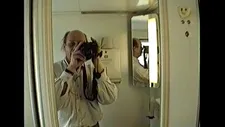 |
| Robby Müller: “The Bohemian life I like very much.” Photo: Claire Pijman |
He taught me a lot, especially coming from film school and thinking, oh, I have to be able to do everything and work with everybody, and to be like the guys. And he said “No, you really have to see with whom you work because it’s so personal and you really have to follow your own path.” It made me relax and it was true, I mainly did my own things.
AKT: It’s Wim week for me, it seems. Yesterday [September 19], I spoke with producer Jeremy Thomas about Wim Wenders. I like the moment in your film when Wim explains how two lines in a script became what we know now as the “road movie.”
CP: Yes, exactly! I was also very surprised. Everyone knew they were the ones making road movies, but nobody knew how it originates.
AKT: It’s a good story. In the beginning there is footage of a dog, Robby’s dog, I suppose, which returns in the end. The dog clearly loves the water.
CP: Yeah. What I like about this footage is … You know, when Robby got ill, there were more people trying to make a film on him and his work. But because he couldn’t speak anymore that was really hard. When he was making a film, it wasn’t just a job, he was putting his whole soul in it. At one point a producer asked me: “Shouldn’t you do this film because you know him so well?” Well, if it’s the kind of film with famous people telling how great he was … You know those kinds of films?
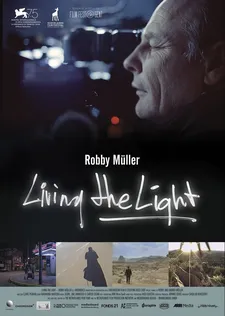 |
| Robby Muller: Remain In Light poster |
AKT: I know those kinds of films!
CP: So I thought, that is not the kind of film I wanted to make. I was working with somebody doing a lot of Hi8 videotapes. I was ingesting into the computer and Andrea had told me that Robby had so many of these tapes, like an archive. So I asked: “Shall I digitize them so you can look at them on the computer?”
When she handed me the box, she said: ”Maybe it will inspire you to make a film on Robby, because nobody now is making this film.” I thought maybe, but then I put in the first tape and I was so struck by it. This is exactly what he talks about! This is his sketch book! I really felt obliged to make this film. I really wanted to pass on his philosophy; this is really how it started.
AKT: And the philosophy is in those moments captured. Someone mentions the view from the Empire State Building to the Flat Iron and then the camera follows the bird! It’s the details!
CP: Exactly! For him it’s not just making a shot, it’s really about looking and connecting with what you see. He filmed out of emotion. If he felt a certain way, he would make an image that fit with it. And that he would use later, that feeling, in his professional life. You can see that so clearly in his “sketchbook.” He also liked a lot that I was doing documentaries and working in a small kind of way, just grabbing what you see.
AKT: There is also what we hear. Jim Jarmusch is responsible for the music in your documentary. You show us how he is talking about coming up with the music, which for him represents his friend, and how Robby loved cloudy days. It’s so interesting how Jarmusch at that moment keeps repeating the name “Robby” in every sentence! It becomes a chant in itself!
 |
| Robby Muller's dog Photo: Claire Pijman |
CP: Well, before making the film, there was this huge exhibition at the Eye Filmmuseum [Master of Light Robby Müller, co-curated by Jaap Guldemond [director of exhibitions] in collaboration with Claire Pijman, Andrea Müller in 2016]. And for that I did the interview with Jim, another interview than what is now in the film. It was for the exhibition, with Wim and with Lars also.
Two years before I was going to make this film, I talked with Jim about him as a musician. The sound person I was with, Pjotr [van Dijk], he said, wow, if you make your film, Jim should do the music! I dropped that idea to Jim and he was like, “Well, let’s see. Just come back when you are really going to make this film.” So two years later I was going to make this film and interviewing him.
I knew he liked guitars a lot. The guitar maker in the film is Flip Scipio, and I had made a documentary before on Flip in 2007. He’s a very famous Dutch guitar maker and I met him at the Buena Vista Social Club shoot. When they were filming here, the whole Cuban band brought their instruments, but they were not in good shape. So they asked this instrument maker to go on tour. He was with Ry Cooder.
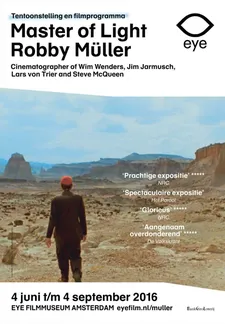 |
| Eye Filmmuseum Master Of Light Robby Müller poster |
On that shoot I met Flip, and he thought that I was German, being with Wim Wenders, and I thought that he was American, being with Ry Cooder. It happened that we were both Dutch. By that time he was already working in New York, making guitars for Paul Simon and Jackson Browne. The film I made was called Talking Guitars and I knew that Jim really liked this film and this guitar maker. So I invite Jim to the guitar maker - that was a way to seduce Jim to do this.
AKT: Well played!
CP: That’s how it came about. Then we edited the film and Jim sent me all kinds of tracks of music and said “Just place it where you want it.” Every track found its place.
AKT: The opening credit music works particularly well - again. I believe once we see the Statue of Liberty, pale, and in the background?
CP: Yes! I was lucky that a friend had this great loft and she offered me to do the interview with Jim there. It’s really nice with the little boat.
AKT: Let’s get to Lars von Trier. I think your choice of clips from Breaking the Waves was wonderful.
CP: As he says in the film, they wanted to do something new and let the camera go and that the operator was always surprised. They didn’t want staged shots, but a documentary feeling. The operator was not allowed to know what to do or where to go. The dancing shot is one of my favourites - the camera goes so perfectly from down to up to the actors. Also the connection of the two people.
AKT: Very much so!
CP: We could see his personal backgrounds in a way. Like Wim tells, how the ending of Paris, Texas was originally a happy ending. And Robby was very very truthful. He likes films and he makes films to learn from. Like, how do you do things in life?
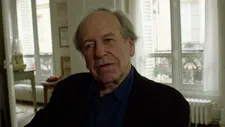 |
| Rüdiger Vogler on Robby Müller: “When Robby is operating the camera you can see if he likes something or not.” Photo: Claire Pijman |
AKT: Yes, that’s why we watch films and why they are important - if they are important. The answering machine sequence - first we hear Jim Jarmusch, then comes David Lynch [who says he chose another DoP for the film he planned]. What became of Ronnie Rocket?
CP: I have no idea. I just found this footage. Robby films how he gets this message, which is really sad. And a lot of DoPs of course recognize this a lot. Also that Robby Müller has moments like this is very good to know. You can see how he feels by the way he filmed that answering machine. Again he s putting his emotion in an image. I did not research what happened with that film.
AKT: When he is filming himself in Michigan for his parents is also fascinating. Another riddle: August 10th and there is this filmmaker he is working with. A film with a riddle in the middle?
CP: Some people might recognize and know what he is talking about. But again, it’s about the message to the mother. You really see what a sweet person he is. How he talks to his mother. You really get to know Robby as a person, not only his work and his craft. It’s really interconnected.
AKT: There is a moment when he is filming his daughter and she says “No, no, don’t,” waking up on her birthday. Seeing something like that in a film, I had to think of Michael Powell’s Peeping Tom, who is experimenting with his child.
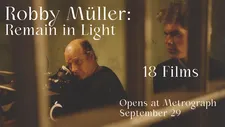 |
| Robby Muller: Remain In Light opens at Metrograph this weekend |
CP: I talked with the daughter who is also in the film. He filmed really everything. He also made connection to people through the camera. It was also a way of communicating for him. I never looked at it like spying or peeping on her. But for her it was, of course! She always had this camera on her. For him it was a way to keep her.
You see all these pictures he has of her. It’s 4/4/1990, his birthday, and on that tape he is filming all kind of pictures in his house of his daughter. And a little birthday card. I know it’s his birthday and people who know him will know that too, giving it an extra dimension. That on his birthday he filmed pictures of his daughter and this birthday card!
AKT: Many details to see for people who discover him anew, and for those who knew his work!
CP: Will we meet in New York?
AKT: That would be nice, when you are coming for your screenings!
CP: Great! I look forward to it. Thank you very much for your time and that you are doing this! Hope to see you, bye!
Robby Müller: Remain In Light opens at Metrograph on Friday, September 29.
Robby Müller: Living The Light screens on Saturday, September 30 and following the Sunday, October I 2:30pm screening, there will be a Q&A with Claire Pijman and and Andrea Müller-Schirmer.





















